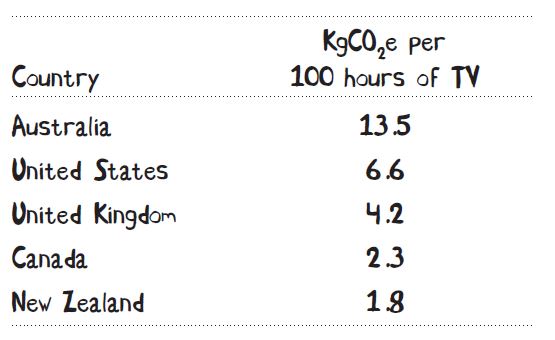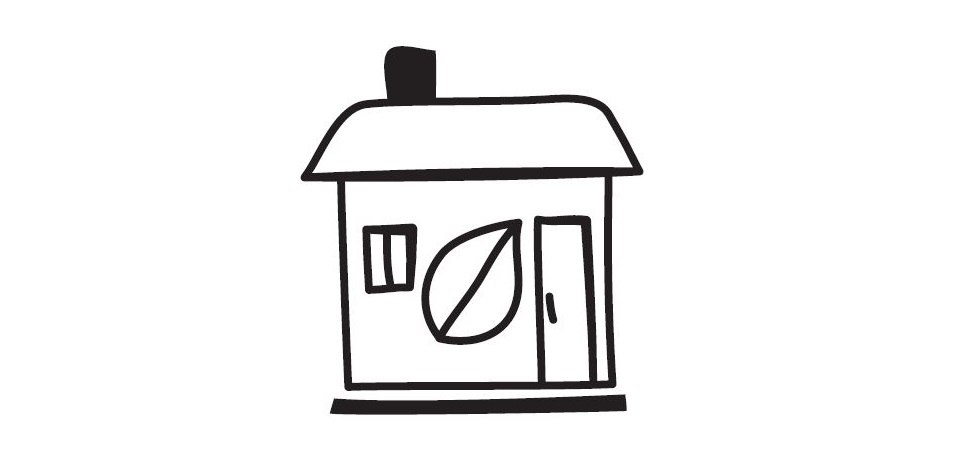- Home |
- Search Results |
- Things you can do in your daily life to reduce your carbon footprint
Things you can do in your daily life to reduce your carbon footprint
Tackling climate change sounds like an enormous task. But your actions make a difference, even the smallest ones, every day. Here are a few simple things you can do right now to reduce your carbon footprint.

Energy consumption
It’s harder to rank actions at home and work by calculating one tCO2e number that is accurate for all cities and countries. If you live in a country that relies on coal power, like Australia or China, choosing to reduce your energy consumption will make a huge reduction to your carbon footprint.
Energy reduction makes a much smaller impact if you’re in a place where the grid relies on hydro (water) power, like Quebec, or nuclear power, like France. In the table below I’ve shown how many kilograms of CO2 would come from 100 hours of watching a big-screen TV in a few nations to illustrate the differences (remember earlier that we identified 1kg of CO2 as a 7km car drive).

Note that emissions will vary by region even inside a country, and that these are based on national annual averages. Assumes a 150 W High Definition television.
The large differences between energy grids might suggest to you that focusing on changing the system is more important than focusing on changing the small behaviours that only affect you. It’s pretty hard for someone living in an area with lots of coal power to get their carbon footprint to a sustainable level because the electricity they use in their home is so carbon-intensive. It’s hard for individuals to be sustainable on our own. We need governments to make change, and the way we can do that is through collective action.
Now there are still some big-picture changes that can be made around the home, but they might not come up often. Our guiding practice in this book is to start with the most important actions and work our way down. In terms of housing, the big things you can do, in approximate order, are:
• live close to work.
• own a smaller home/share your living space.
• get renewable energy.
• weatherproof your home and purchase energy-efficient appliances.

Living close to work
Living close to work is mostly about shrinking the footprint of your commute. If you live in the area of the city or town where you also work, it is more likely that you live in an area where everything you need is closer to you so you can walk or take public transport instead of drive. Real estate is more expensive in denser areas, so if you live closer to where you work you probably have a smaller living space too. Apartment buildings, condos and row houses share walls, making them easier to heat and making your personal energy consumption lower than someone living in a detached house. When you have less space, you also have fewer things, which come with their own carbon footprint as well. For these reasons, studies show that households in denser, urban environments have lower carbon footprints than households in the suburbs. But there is one issue: households in dense, urban areas sometimes have higher emissions than expected because their occupants fly more. A couple of trips by plane can undo a lot of good accomplished by an otherwise sustainable lifestyle.
Shared living space
Sharing your living space is a similar way to reduce your climate impact without needing to constantly remind yourself to do something. Each person added to a household reduces per capita emissions by somewhere between 6 per cent and 9 per cent (about 1.4 tCO2e in the United States). Larger households live with less environmental harm simply by sharing – and not just living space. They share heating, transportation, refrigerators, washing machines, cutlery and wifi, and it all adds up. I recognize that this isn’t a decision that you can make every day. But it’s good to know that families taking on students in a spare room and single people splitting rent with roommates are doing more than just saving money.

Renewable energy
There are a couple of ways to get renewable energy for your home. If you own your house, install solar panels on your roof. There is an up-front cost but that gets paid off over time, eventually earning you back savings and in some cases, increasing the value of your home. Different jurisdictions have different incentives that can make this pay-back time longer or shorter. Research what those are as well as who to hire in your area. The benefit to the climate can be substantial. And don’t forget that an action like installing solar panels is one of those contagious actions where your decision can have a ripple effect in your community. Depending on where you live there may be an option to install geothermal energy as well!
If you don’t own your own house, but you still pay for your own heating and energy, you can check with your utility company and see if you can switch to renewable energy. I currently pay a small extra fee so that my share of the natural gas that heats my home is sourced from decomposing organic matter at a landfill, instead of from a fossil fuel deposit taken from the ground. Some utilities also allow you to purchase electricity derived from renewable sources (solar, wind, etc.).
On top of these changes, ideally, you’d want your money to be funding a growing renewables market that creates additional green energy that goes into the grid. Findings have shown that some energy companies are using customer money to pay for “green electricity” that already exists (like an old hydroelectric dam rather than the construction of a new wind turbine). If you switch to a renewable energy source, do some research yourself to see if your money is being spent transparently on new projects that help reduce reliance on fossil fuels.
Weatherproofing and efficient appliances
If you own your own home, then you can reduce your home energy use by better weatherproofing. Here are some of the ways you can keep heat in the house during colder months:
• cavity wall insulation
• loft insulation
• double- or triple-glazed windows
• draught stoppers under doors.
Energy-efficient appliances can reduce your home electricity use. Look for energy labels when you purchase new appliances and compare with the other products available. There are a few up-and-coming technologies to consider adopting early, for example: an induction stovetop. These are more responsive and safer than gas stovetops but use electricity, so their effect on the climate is smaller (especially as nations decarbonize their energy grids). Heat pumps are more efficient than air conditioners and heaters and can do the job of both. They move heat indoors in the winter and outdoors in the summer (using similar tech to a refrigerator cooling system). Both of these technologies are developing, so expect their costs to drop as time goes on.
Laundry
I often get asked to recommend the most effective actions for the climate that are also the easiest. I really don’t like the framing of that question. It says that the future of the planet is less important than convenience. Or maybe it shows a failure to comprehend the gravity of the situation we’re in. Regardless, I do recognize that people can get fatigued by taking on too many changes. For that reason, there are other actions that are pretty easy to do and still conserve energy enough to meaningfully affect your carbon footprint. A couple of these involve laundry.
Anything that involves heating up a lot of water will require a lot of energy. If you can, wash your clothes in cold water as often as possible to cut back on energy. All you have to do is set your washing machine to cold, and modern detergents work equally well in cold water. Then once you’ve done your laundry, air dry it on a clothes rack or outside on a washing line rather than using a dryer. This takes a little more work (and if you have moths or other pests then you may need to wash clothes with hot water or use a dryer to keep them at bay), but it’s less hard on your clothes, so they will last longer. Washing with cold water and air drying clothes combined save a little more than 0.4 tCO2e each year, assuming you do them all year long.

Lighting
We often think of turning off the lights as being an environmentally aware action. But these more visible behaviours (e.g. lighting) are much less effective than onetime behaviours that are hidden out of sight (e.g. installing a more efficient water heater). If you want to reduce the energy you use for lighting, switch to efficient lightbulbs, like LEDs.
Heating
Setting your thermostat to be a couple degrees cooler in the winter, and your air conditioner to be a couple degrees warmer in the summer, is a worthwhile change. If you can substitute a fan for the AC that’s an even better solution for summer heat.

Eeny, Meeny, Miny, Moe
We’re faced with dozens of decisions each day. These choices aren’t going to change the world, and some of them won’t have that big of an effect on your carbon footprint. But if you care about climate change, and you don’t like waste, then there are some questions you might want to have answered:
• Blow dry my hands or use a paper towel? The best answer is to wipe your hands on your trousers and move on! Often the best answers for the environment aren’t fancy technology, they’re plain and simple.
• Paper or plastic? For grocery bags it all depends on how many times you reuse them. Plastic bags have a smaller carbon footprint than paper or even canvas bags, but you can’t get as many uses out of them. The key here is to get one canvas bag and reuse it a lot – aim for over 100 times.
• Cat or dog? I’m a dog person myself, but in terms of carbon footprint cats have an edge. Most of the footprint of an animal comes from what they eat, and since dogs are usually bigger, they usually eat more. But cat food tends to have more protein, so on a gram for gram level it is likely to be more carbon intensive. Outdoor and free-range cats are prolific bird killers, estimated at 1.3–4 billion birds every year in the United States, which is not good! Other pets (rabbits, turtles) have a smaller footprint because of their size and diet (no meat). You can also reduce the footprint of your pet by not overfeeding them.
• Ecolabel cleaning product or bleach? I’m going to pull a fast one again and say neither. Have you tried white vinegar? Or vinegar paired with baking soda? These are options that don’t require the same industrial intensity as something like bleach.
• E-reader or hardcover books? Depending on the study, the average book has a carbon footprint of around 2 kgCO2e per kilogram of weight. The physical copy you have in your hands, for instance, weighs much less than a kilogram – so if these pages inspire you to forego eating a single hamburger you will have likely come out ahead. An e-reader has a much larger carbon footprint (20–40kgCO2e per e-reader), so to offset the e-reader you would need to not purchase about 40 physical books. The best option is to borrow from the library.

Bigger, Newer, More Is Not Better
Hidden among the noise of household changes are all of the hundreds of decisions that contribute to an over-consumptive lifestyle. Buying a new mobile phone when your old one works perfectly well. Having a closet full of clothes, many of which you don’t wear. Living in a five-bedroom home occupied by just yourself and your partner. I can’t put a number to the sum of all these actions, but they can add up. As a society, we need to move away from retail therapy and embrace lives that find meaning outside of consumption.
SOS: What You Can Do To Reduce Climate Change by Seth Wynes is out now.